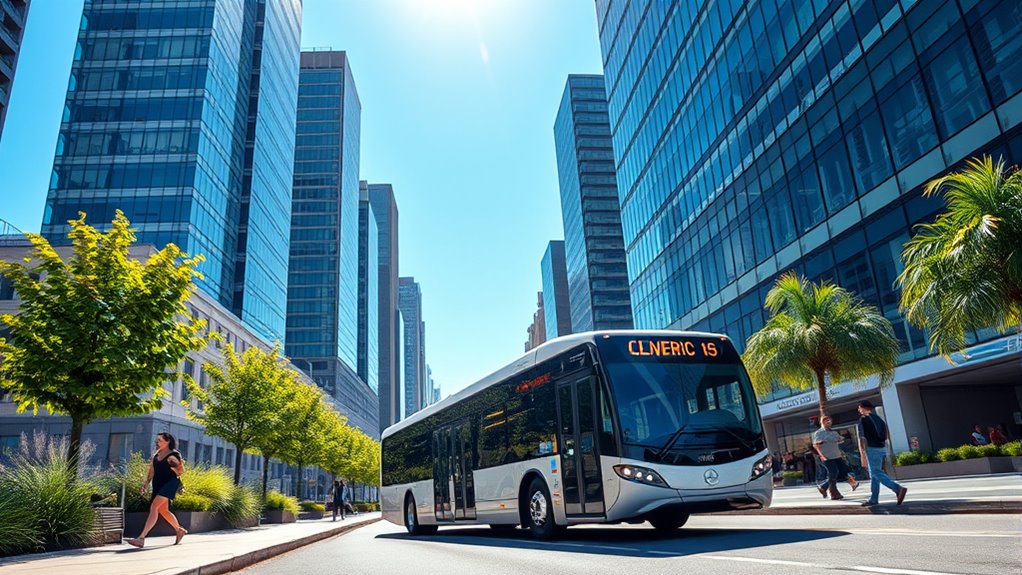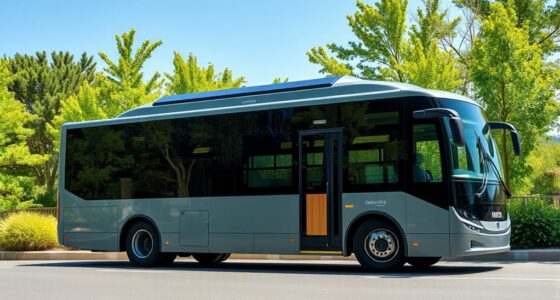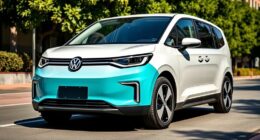Electric buses help clean your city’s air by shutting out diesel fumes and reducing harmful pollutants like nitrogen oxides and particulate matter. This means fewer health risks, especially for vulnerable groups, and less indoor air pollution in bus depots. They also cut greenhouse gases, supporting cleaner and healthier communities. With ongoing advancements, electric buses are becoming more affordable and reliable. Keep exploring to see how these changes can make your urban environment safer and more sustainable.
Key Takeaways
- Electric buses eliminate tailpipe emissions, reducing particulate matter, nitrogen oxides (NOx), and ozone-forming pollutants.
- They improve indoor air quality at depots by removing diesel fumes and harmful exhaust.
- Transitioning to electric buses lowers overall city air pollution, reducing health risks like asthma and respiratory issues.
- Lower emissions from electric buses contribute to cleaner ambient air and support urban air quality standards.
- Widespread adoption decreases greenhouse gases, mitigating climate change-related air pollution impacts.

Electric buses are transforming urban transportation by considerably reducing air pollution and greenhouse gas emissions. As you ride or see these buses on the streets, you’re witnessing a significant step toward cleaner air in cities. Unlike traditional diesel-powered buses that emit particulate matter and ozone-forming pollutants, electric buses eliminate these harmful exhaust emissions. This means less pollution in the air you breathe, directly lowering respiratory and cardiovascular health risks for everyone, especially vulnerable populations.
Electric buses significantly cut air pollution and protect public health in cities.
Reduced pollutants like nitrogen oxides (NOx) and sulfur oxides (SOx) help decrease asthma episodes and premature deaths linked to air pollution. Additionally, electric buses improve indoor air quality in bus depots by removing diesel fumes, creating healthier environments for drivers and maintenance staff.
Beyond local air quality, electric buses also contribute to global climate efforts. They produce less than half the greenhouse gas pollution of diesel or natural gas buses. If all U.S. transit buses switch to electric, over 2 million tons of CO₂ emissions could be eliminated annually. This reduction supports your city’s climate goals and helps mitigate urban heat island effects caused by vehicle emissions.
Even in regions with coal-heavy electricity grids, electric buses tend to have lower lifecycle emissions compared to diesel counterparts. As the grid becomes cleaner with more renewable energy, the environmental benefits only grow, enabling your city to become more sustainable over time. Advancements in battery technology are making electric buses more affordable and increasing their range, encouraging broader adoption.
Public health benefits are another compelling reason to embrace electric buses. Each bus can save around $55,000 annually in health costs by reducing pollution-related illnesses. When cities electrify their entire fleet, they prevent billions of dollars in health costs and reduce hospitalizations associated with air pollution exposure. Moreover, battery recycling initiatives are emerging to manage the environmental impact of used batteries responsibly. Additionally, ongoing research into renewable energy integration promises to further decrease the lifecycle emissions of electric buses, making them an even cleaner transportation option in the future.
These improvements particularly benefit communities near transit corridors, which often face higher pollution levels and health disparities. By decreasing pollution, electric buses lessen the healthcare burden linked to respiratory and cardiovascular diseases, making your city healthier overall.
Operational costs also favor electric buses. They typically save over $25,000 each year on fuel, thanks to lower energy costs and more efficient operation. Maintenance costs drop because electric motors have fewer moving parts than diesel engines, and regenerative braking reduces wear and tear on brakes.
You’ll find that these buses are more reliable, with less operational downtime. While the upfront purchase cost can be higher, these savings, plus predictable energy prices, allow cities to recover expenses over about 12 years. The quieter operation of electric buses reduces urban noise pollution, making neighborhoods and transit hubs more peaceful and safer for pedestrians.
The adoption of electric buses continues to grow, with cities like Chicago already deploying dozens and planning more. Major manufacturers are expanding production, and federal or state incentives help lower purchase barriers.
Furthermore, battery technology advancements are making electric buses more affordable and increasing their range, encouraging broader adoption.
Frequently Asked Questions
How Do Electric Buses Impact Urban Noise Pollution Levels?
You’ll notice that electric buses markedly reduce urban noise pollution. They eliminate engine and exhaust sounds, operate more quietly during acceleration and deceleration, and avoid gear-shift noise.
This results in a measurable decrease of up to 4.4 dBA during peak hours, helping to lower stress and improve sleep for city residents.
What Is the Lifespan Comparison Between Electric and Diesel Buses?
You might think electric buses don’t last as long as diesel ones, but that’s not entirely true. Electric buses typically have a lifespan of up to 10 years, which is comparable to diesel buses that often last longer due to their durability.
While electric buses may need battery replacements over time, their overall lifespan can match diesel models, especially with proper maintenance.
How Do Charging Station Locations Affect Bus Deployment Flexibility?
Did you know that strategic charging station placement can boost bus deployment flexibility by up to 20%? When you choose between depot and on-route charging, you directly influence operational efficiency.
Placing chargers thoughtfully minimizes deadheading and reduces infrastructure costs, allowing you to run more routes with fewer disruptions. By optimizing location strategies, you can enhance route adaptability, improve service reliability, and better meet the evolving demands of city transit systems.
Are There Any Safety Concerns With High-Voltage Electric Bus Batteries?
You should know that high-voltage electric bus batteries raise safety concerns, mainly fire risks and thermal runaway if damaged. While rare, fires can occur, and emergency responders face challenges like electric shocks.
However, manufacturers implement safety features, rigorous standards, and regular maintenance to mitigate these risks. Proper training and advanced management systems help ensure safe operation, making electric buses a safer choice despite these concerns.
What Are the Economic Benefits of Switching to Electric Buses?
Switching to electric buses offers notable economic benefits. You’ll save money on fuel since electricity costs less than diesel, and maintenance becomes cheaper because electric motors require less upkeep.
Plus, electric buses last longer, reducing replacement costs. Many regions also provide incentives, making the switch more affordable.
Conclusion
Think of electric buses as the gentle rain that clears away the city’s smoky clouds. As you embrace this change, you become a part of the fresh breeze sweeping through urban streets, revitalizing the air we breathe. Just like a gardener tends to their plants, your support helps nurture cleaner air and healthier communities. Together, we can turn our city into a vibrant garden where every breath feels lighter and brighter.









